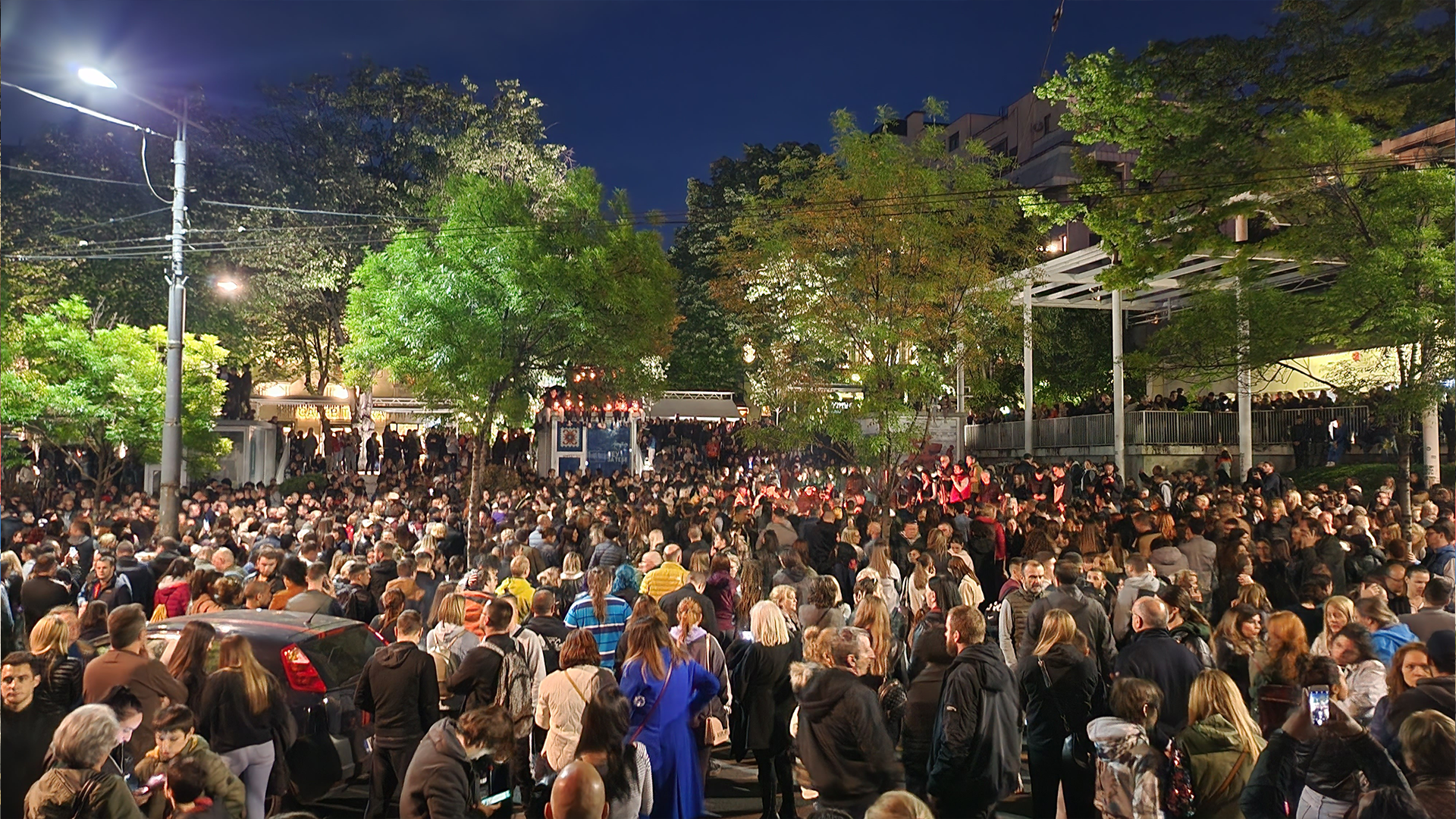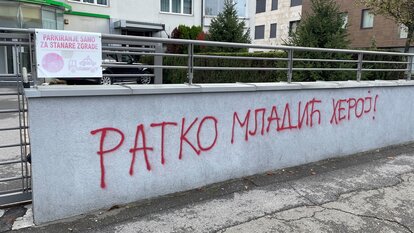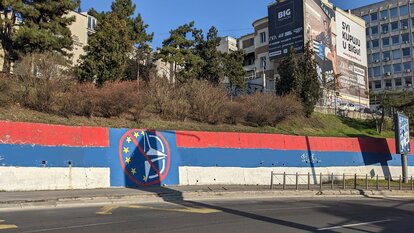Serbia
He who sows violence

Menschen versammeln sich am 3. Mai 2023 in der Nähe des Ortes einer Schießerei in einer Schule in Belgrad, Serbien. Die serbische Regierung hat drei Tage der Trauer ausgerufen, nachdem ein bewaffneter Jugendlicher am Mittwochmorgen in einer Grundschule in Belgrad neun Menschen getötet und sieben verletzt hat.
When a total of 18 mostly young people lost their lives in two rampage killings on 3 and 4 May, Serbia was in shock. Encouraged by the bloody deed of a 13-year-old who had murdered nine schoolchildren and a retired security guard in Belgrade the day before, a 21-year-old killed another eight young people in two villages south of the capital just one day later. There had not been such an outbreak of violence since the wars of the 1990s; people wrestled with their anger and grief, and the entire country struggled to keep its composure.
While the people of Serbia sincerely sympathized with the fate of those killed, the press, as usual, fell prey to sensational journalism: the media immediately published not only the name and photo of the 13-year-old perpetrator, but also his “hit list” with the clear names of his classmates. President Aleksandar Vučić disregarded several privacy laws when he revealed details from the boy’s medical history, only to ponder the reintroduction of the death penalty a short time later. For the government, the case was clear: at the first press conference after the school massacre, Education Minister Branko Ružić blamed “Western values.” He stated that Serbian society had to decide to what extent it wanted to accept Western behaviour.
In the past, Vučić’s Serbian Progressive Party (SNS) had done well in deflecting attention from real problems by arousing nationalist feelings. This time, however, sympathy for the victims turned into social protest: Under the slogan “Serbia against violence”, tens of thousands of people gathered in Belgrade and Novi Sad, Serbia's second-largest city, for silent marches for the eighteen victims three days after the bloodshed. It quickly became clear that there was more at stake than two massacres: the omnipresent violence in Serbian society and its acceptance by the government and its sympathetic media.

Ein Graffiti in Belgrad, das den Kriegsverbrecher Ratko Mladić als Helden verherrlicht.
© Friedrich-Naumann-Stiftung für die FreiheitViolence and aggression are omnipresent
Every day, Serbian media give the impression that violence is an acceptable means of asserting interests. A dozen tabloids incessantly rant about real or fictitious violence and threats - a study a few years ago found that the country's two largest tabloids alone announced war with Kosovo no less than 265 times in one year. Since the Russian invasion of Ukraine, pro-Russian TV channels have been declaring and glorifying the war of aggression as Russia's legitimate means of self-defense in hours-long live broadcasts every day. The media, and with them Serbian society, are fascinated by violent criminals: for example, a mafia boss convicted of multiple murders was recently given his own TV talk show after his release. And almost daily, live and in prime time, the president denigrates critical journalists and opposition figures, who he considers “enemies of the state” and “traitors to the people”.
More and more people in Serbia are realizing that what is at stake is nothing less than the brutalization of Serbian society. If you talk to people on the street, quite a few of them attribute the brutalization of public discourse to the ruling Serbian Progressive Party (SNS) around its leader Vučić. Thus, citizens feel a sense of powerlessness in the face of a state in which one often gets one's rights solely through money or connections. In the Global Organized Crime Index, Serbia ranks second in Europe for organized crime, surpassed only by Russia. Corruption is omnipresent, whether on a grand scale in the construction industry or on an everyday basis when visiting a doctor. Those with ties to the regime are protected. From craftsmen to mafia bosses.
The brutalization of society is also evident in everyday life: since the beginning of the year, eighteen women and girls have already been murdered by their partners in Serbia. For years, the government has tolerated hundreds of graffiti in public spaces glorifying the war criminal and perpetrator of the Srebrenica genocide Ratko Mladić as a “Serbian hero.” The autocratic populist SNS maintains close ties with nationalist thugs who ensure that citizens have to put up with violence and intimidation. The monopoly on the use of force has long since ceased to lie with the state, but with the party that has taken it over.
While government officials mock the demonstrators, calling them hyenas and “Serbia-haters”, the dominant pro-government media try to downplay the peaceful protests. The following weekend, when tens of thousands of people again gathered for a mass demonstration in Belgrade and blocked important bridges, the tabloid “Informer” wrote of “a few hundred chaotic people” who had harassed innocent citizens. TV stations show aerial footage of scattered small groups, apparently taken hours earlier. When the size of the protests can no longer be denied, even thanks to social media, Prime Minister Ana Brnabić, in her best autocratic manner, blames the protests on “foreign powers that wanted to destroy Serbia.”

Auch EU- und NATO-feindliche Botschaften sieht man überall im Stadtbild.
© Friedrich-Naumann-Stiftung für die FreiheitShowdown this weekend
Last Friday, according to reputable estimates, up to 300,000 people gather in Belgrade for the largest demonstration yet to demand an end to violence and hate speech in the media and politics. Serbia last saw such large gatherings thirty years ago at the fall of Slobodan Milošević. And the dispute seems to hark back to that time: for example, President Vučić has announced a “large national gathering” in support of the SNS government next Friday, with over a million participants. It is rumored that the party has hired over 2,200 buses nationwide to move party supporters and public sector employees to Belgrade. Everyone seems to know someone who is being coerced by their pro-government employer to participate in the pro-regime protests. Organizations critical of the government such as FNF partner CRTA are already collecting incoming complaints.
In contrast, party symbols are rarely seen at the anti-government rallies. “The protests are political, but they are not party political”, says Pavle Grbović, leader of the liberal Free Citizens Movement (PSG). “They are an expression of a social feeling, not of party political opinions. People have taken to the streets because of rampant injustice, and against a government that makes a mockery of their legitimate interests.”
The people who took to the streets for a free and open Serbia are determined to continue their protest, no matter how many compatriots the regime brings up on Friday. The next demonstration of “Serbia against Violence” is planned for Saturday. For the first time in many years, Aleksandar Vučić, the populist ruling president, seems to have lost his sense of the mood on the street. As Slobodan Milošević's former minister of information, he witnessed firsthand in 2000 how Serbians chased his then-boss out of office with mass demonstrations. Back then, people took to the streets because of economic concerns; today, they do so because of the questionable opinion-making of their government, which apparently knows no moral boundaries. Aleksandar Vučić’s reputation is tarnished. But tarnished autocrats are unpredictable.
Markus Kaiser is project director for the Western Balkans for the Friedrich Naumann Foundation for Freedom, based in Belgrade.
